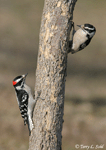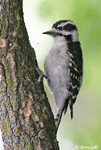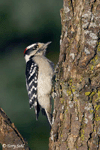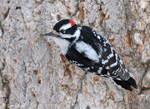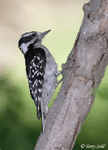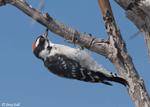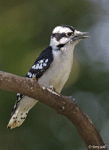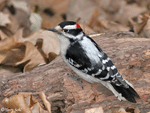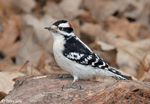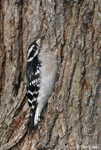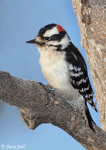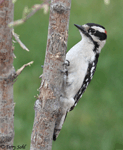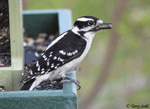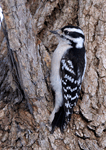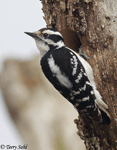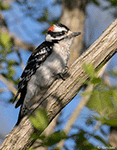| Length: 6.5 - 7 inches | Wingspan: 11 - 12 inches | Seasonality: All Seasons |
| ID Keys: Small size, short stubby bill, black spots on white outer feathers of tail, relatively quiet call. Males have a red patch on the back of their heads. | ||
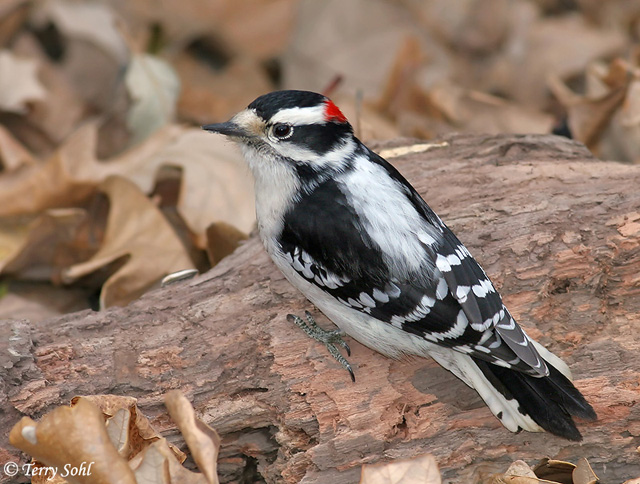 The Downy is the smallest Woodpecker in North America. It's found in
forests and woodlands throughout the state, as well as residential areas and parks,
They are one of the most common, and consistent, visitors to feeders, attending
feeders at all times of the year. During the winter, they are often found with
mixed flocks including other species such as chickadees and nuthatches. Note the very similar markings of the Hairy
Woodpecker, which has a larger size and longer bill (see the "similar species"
section below for identification tips). A male is
pictured to the right. Females are similar, but don't have the red
patch on the back of the head (see photos at bottom of the page).
The Downy is the smallest Woodpecker in North America. It's found in
forests and woodlands throughout the state, as well as residential areas and parks,
They are one of the most common, and consistent, visitors to feeders, attending
feeders at all times of the year. During the winter, they are often found with
mixed flocks including other species such as chickadees and nuthatches. Note the very similar markings of the Hairy
Woodpecker, which has a larger size and longer bill (see the "similar species"
section below for identification tips). A male is
pictured to the right. Females are similar, but don't have the red
patch on the back of the head (see photos at bottom of the page).
Habitat:
Downy Woodpeckers can be found in a very wide array of habitats, where suitable trees are available for nesting cavities. They are primarily found in deciduous woodlands and forests, often around forest clearings and edges. In South Dakota, riparian areas with riparian forest cover are a favored habitats. They can be found in a number of settings established by humans, such as established suburban areas with older trees, parks, shelter belts, and farmstead wood lots.
Diet:
Mostly insects. Also eats seeds and berries, as well as nuts and suet at feeders.
Behavior:
Will forage at nearly any level of vegetation. Due to it's small size, it can climb through smaller branches and twigs when looking for food than can many other woodpeckers.
Nesting:
May through July. The nest of a Downy Woodpecker is a cavity in a tree, usually a dead deciduous tree or a dead tree branch. Both the male and the female help construct the nest cavity, with the end result a cavity that's generally between 8 and 12 inches deep. No material is added to the nesting site other than wood chips from the construction activity. The female lays between 3 and 6 eggs, and both parents help to incubate them. When the eggs hatch, both parents help feed and tend to the young. The young leave the nest after about 3 weeks.
Song:
Both male and female Downy Woodpeckers will "drum", a rapid drumming that's consistent in pace and generally quieter than that of some of their larger woodpecker relatives. A crisp pik note is often given as a contact or alarm call. Similar sharp pik notes are also often strung together in a rapid-fire chattering call, often heard during the breeding season.
- Click here to hear the drumming of a Downy Woodpecker1
- Click here to hear the crisp pik calls of a Downy Woodpecker2
- Click here to hear the excited pik calls of an excited Downy Woodpecker3
- Click here to hear the rapid-fire chattering of a Downy Woodpcker4
Migration:
Considered non migratory throughout their very extensive range.
Interactive eBird Map:
Click here to access an interactive eBird map of Downy Woodpecker sightings
Similar Species:
In South Dakota, there's one species that is often confused with a Downy Woodpecker, and another that also could cause an identification issue. Downy Woodpeckers are also similar to a few other woodpecker species that aren't normally found in South Dakota. The following are the species most likely to be confused with a Downy Woodpecker:
- Hairy Woodpecker - A very common challenge for birders is differentiating between Hairy Woodpeckers and Downy Woodpeckers. The plumage patterns are very extremely similar. Hairy Woodpeckers are larger than Downy Woodpeckers, but size alone can be difficult to judge when a bird is seen by itself. Bill length is the other most obvious structural feature, as Hairy Woodpeckers have a longer, more robust bill that is nearly as long as the head length, while the bill of a Downy Woodpecker is much shorter than the overall head length. A sometimes difficult to see identification key is the coloring on the outer tail feathers, which are all white on a Hairy Woodpecker, but are white with some black spots on a Downy Woodpecker. Finally note behavior and abundance are often a clue. Downy Woodpeckers are generally the more abundant of the two species, and they tend to be more bold than the often shy Hairy Woodpecker. For more information on identifying Hairy vs. Downy Woodpeckers, see this Comparison Chart.
- Yellow-bellied Sapsucker - Yellow-bellied Sapsuckers are found in the eastern half of South Dakota in migration and during the summer months. They share a generally similar black and white plumage pattern on the body, with a few differences as noted here. Yellow-bellied Sapsuckers are a larger species, but size alone can be difficult to judge unless the two species are side-by-side. Yellow-bellied Sapsuckers, as with other sapsucker species, have a bold, obvious white wing patch that's lacking on a Downy Woodpecker. Both male and female Yellow-bellied Sapsuckers have a red crown that's lacking on Downy Woodpeckers. Male Yellow-bellied Sapsuckers have a red throat and white on the back of the head, while a male Downy Woodpecker has a white throat and a red patch on the back of the head.
- Nuttall's Woodpecker - Not an identification challenge in South Dakota but in the quite limited range of a Nuttall's Woodpecker (primarily California and Baja California), they are quite similar in size, structure, and appearance to a Downy Woodpeckers. Plumage on the back is one easy identification feature, as Nuttall's Woodpeckers and a black and white barred pattern, while Downy Woodpeckers have a broad white patch surrounded by black. Nuttall's Woodpeckers have scattered black barring and spots on their flanks, while the underside of a Downy Woodpecker is all white. Male Nuttall's Woodpeckers have more extensive red on the back of the head, while that on a male Downy Woodpecker is just a small patch.
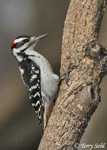 |
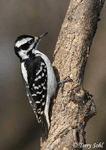 |
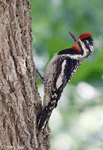 |
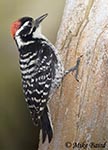 |
| Hairy Woodpecker (male) | Hairy Woodpecker (female) | Yellow-bellied Sapsucker (male) | Nuttall's Woodpecker (male) |
Conservation Status:
Systematic surveys over the last few decades (Christmas Bird Count, Breeding Bird Survey) show quite stable populations overall. They are found across a very broad geographic area, are very common in many parts of that range, and have very high population numbers overall. The IUCN lists the Downy Woodpecker as a species of "Least Concern".
South Dakota "Hotspot":
Downy Woodpeckers are typically around in most of the state where there are woodlands and forests available to build nesting cavities. Established feeders are the best place to consistently see them, but wherever you have suburban areas with established trees, parks, forested riparian areas, woodlots, shelter belts, or other areas of substantial numbers of trees, there are likely some Downy Woodpeckers around.
Bird Feeders:
Downy Woodpeckers are often one of the most frequent and consistent visitors to feeders once a feeding location has been established and maintained over time. They will come for a variety of items, but their favorites are suet, peanut butter, black-oil sunflower seeds, and various nuts..
Further Information:
- USGS Patuxent Bird Identification InfoCenter, Downy Woodpecker
- WhatBird - Downy Woodpecker
- Audubon Guide - Downy Woodpecker
Photo Information:
November 7th, 2007 - Big Sioux Recreation Area near Brandon, South Dakota - Terry Sohl
Additional Photos:
Click on the image chips or text links below for additional, higher-resolution Downy Woodpecker photos.
Audio File Credits:
- 1Sue Riffe. Recorded in Boulder County, Colorado on May 5th, 2020. Original recording and information are available on xeno-canto.
- 2Will Sweet. Recorded in Norfolk County, Massachusetts on January 28th, 2018. Original recording and information are available on xeno-canto.
- 3Paul Marvin. Recorded in Brevard County, Florida on April 24th, 2018. Original recording and information are available on xeno-canto.
- 4Martin St-Michel. Recorded in Quebec on May 17th, 2015. Original recording and information are available on xeno-canto.
| Click on the map below for a higher-resolution view |
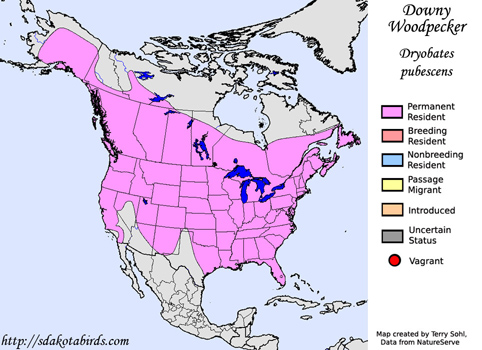 |
| South Dakota Status: Common permanent resident throughout the state. |
Additional Downy Woodpecker Photos
Click for a higher-resolution version of these photos
